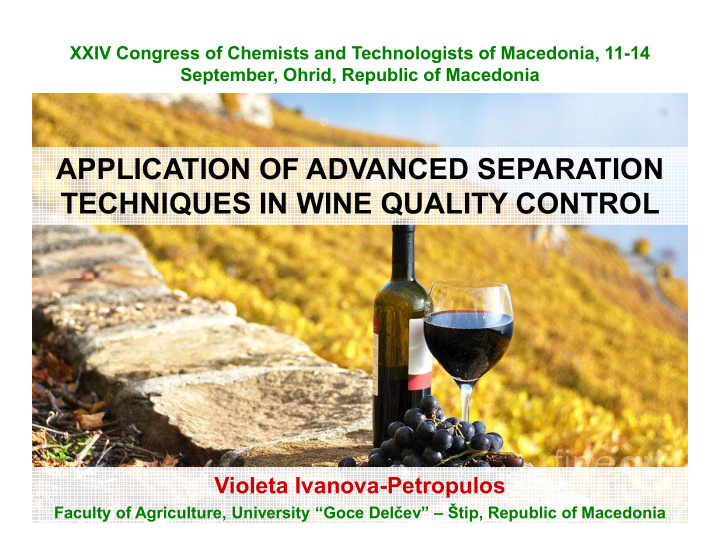



XXIV Congress of Chemists and Technologists of Macedonia, 11(14 September, Ohrid, Republic of Macedonia APPLICATION OF ADVANCED SEPARATION TECHNIQUES IN WINE QUALITY CONTROL Violeta Ivanova(Petropulos Faculty of Agriculture, University “Goce Delčev” – Štip, Republic of Macedonia
INTRODUCTION � The grape vine is the source of all wine. � Highest level of quality in wine is only possible by starting with the highest HOW MANY GRAPE VARIETIES quality fruit. ARE GROWN? � Grapes are the largest fruit crop on earth � Fairly adaptable plants, growing in a wide variety of soil types, Fairly adaptable plants, growing in a wide variety of soil types, Several thousand to be precise, Several thousand to be precise, temperatures, climate. but a few hundred are actually � Successfully grown in Europe, the Balkans, Asia, Mediterranean and used for wine making. South Africa, South Australia and New Zealand, most of North America and a good portion of South America. The vine plant can produce fruit for up to 100 years.
� ��� ����� ���������� ������� ���������� ���������� ������� ����� ����� �������� ���������� �������� ������ �������� Stanušina Vranec Vranec Merlot Merlot Stanušina Vranec Vranec Merlot Merlot � ����� ����� ���������� ���������� ���������� � ������� ������� � � �������� � ��������� ��������� ���������� ��������� � ��������� ��������� !����� ������ "������� #������� !����$!���� Smederevka Smederevka Žilavka Chardonnay
In order to improve the quality of wines, research in viticulture and enology is necessary: 1 to improve the grape quality and ripening, 1 to select yeast inoculums and enzymes, 1 to control the conditions during the malolactic fermentation as well as the aging process. A sound knowledge of wine chemistry is also necessary. Chemical Analysis Several analyses are essential: pH pH free and total sulfur dioxide titratable acidity reducing sugar alcohol protein stability (for whites and low(tannin reds) potassium bitartrate stability MLF status, biological stablity Proper and controlled sensory analysis These are the very minimum analyses, ADVANCED ANALYSES NECESSARY!!
ADVANCED ANALYSIS Determination of: 1 specific parameters, 1 individual compounds, 1 compounds in low concentration@. ADVANCED ANALYTICAL TECHIQUES: 1 GC( MS (volatile compounds determination: esters, alcohols, terpenes) 1 HPLC, CE with DAD or MS (non(volaticle compounds determination: polyphenols, organic acids, carbohydrates, biogenic amines, pesticides@ 1 MALDI(TOF(MS – identification and structural characterization of big and unknown molecules 1 NMR
AROMA COMPOUNDS AROMA COMPOUNDS � Wine aroma represents a good balance of a several hundred volatile compounds. � Some volatile compounds originate from the grapes where they are synthesized. � Most of them are formed during the process of � Most of them are formed during the process of grape must fermentation and afterwards, during the storage of wines. � All changes of aroma compounds affect the complexity of the aroma profile of wines.
GAS CHROMATOGRAPHY GAS CHROMATOGRAPHY � Aroma compounds are usually analyzed by gas chromatography/mass spectrometry (GC/MS ), as a highly efficient separation technique for volatiles’ analysis and for characterization of the wine bouquet. � GC1MS is also suitable for quantification purposes, using polar column for separation of the components, since it is more sensitive for analysis of components present in a low concentration, as well as, in a complex of components present in a low concentration, as well as, in a complex matrices, as wine is. � Extraction methods: solid1phase extraction (SPE), solid1phase microextraction (SPME), stir bar sorptive extraction (SBSA), or Liquid( liquid extraction methods using organic solvents (dichloromethane), showing high repeatability Ivanova et al. ���� ���������� ������� , 5, 1427(1434, 2012 Ivanova et al. ���� ��� ���������� ����������� 6(6) 1609(1617, 2013
An automated HS1SPME combined GC1MS is highly efficient separation technique for extraction and separation of wine aroma compounds � SPME fiber was used: DVB/Carboxen/PDMS 50/30, 2 cm stable flex � the samples were equilibrated in the oven of the autosampler at 40°C for 5 minutes � SPME fiber was exposed into the headspace of the sample for 20 minutes at 40°C � transferred to the GC1injector for thermo1desorption at 270°C
Complex aroma profile of Vranec samples � 18 alcohols: isoamyl alcohol – dominant alcohold, followed by 21methyl111butanol, phenylethyl alcohol, isobutyl alcohol and 11hexanol � 29 esters: ethyl acetate 1 dominant ester, followed by butanedioic acid diethyl ester, 11butanol131methyl acetate butanedioic acid diethyl ester, 11butanol131methyl acetate and propanoic acid ethyl ester � 7 fatty acids: octanoic acid 1 dominant one, followed by hexanoic acid � Carbonyl compounds: � (heptanal and decanal were the main compounds
PHENOLIC COMPONENTS PHENOLIC COMPONENTS � Determine the colour, mouth feel, astringency and bitterness of wine. � Influence the sensorial characteristics of grape and wine � Antioxidant, antimicrobal, anticancerogenic effects, effects, prevention prevention of of cardiovascular cardiovascular diseases. Two groups of polyphenols Two groups of polyphenols: : ���������� ���������� ��� ���� ����������� ����������
UV(Vis spectra of vitisin A and vitisin B
HPLC HPLC(DAD analysis of red wine DAD analysis of red wine Stanušina ������ ������������ �� ����� š ��� ���� ������ �������� �� ��� ��� ��� �� ��� ��� �� ��� ���������� ��� �������������� �� ������������� ��� ��������!�����"�#���$�� ����� ��� �����"��������� ����� ���� ��� ��� �������� ���% &��' ��������������( ������ ����� )*+, )-+���������� )�+, )�+������������ ������� )�+, �������� ����� )�+, �������� ����� )�+, ������� ����� ).+, �������� ����� )/+, ������������������������ )�+, ���������������������� )0+, ��������������������� )*�+, ��� ����������������� )**+, ������ 1� )*�+, ����������). ������+������������� )*�+, ���������). ������+������������� )*�+, ��� �����). ������+������������� )*�+, ��������� ���������������������� )*.+, ��� ��������������������������� )*/+
Mass spectrometer • Mass spectrometry (MS) is an analytical technique that ionizes chemical species and sorts the ions based on their mass to charge ratio. • Mass spectrum measures the masses within a sample. • Mass spectrometry is used in many different fields and is applied to pure samples as well as complex mixtures. applied to pure samples as well as complex mixtures. • Used for: • characterization of complex structures of compounds • detection of new compounds in different matrices • @@@
Recommend
More recommend